
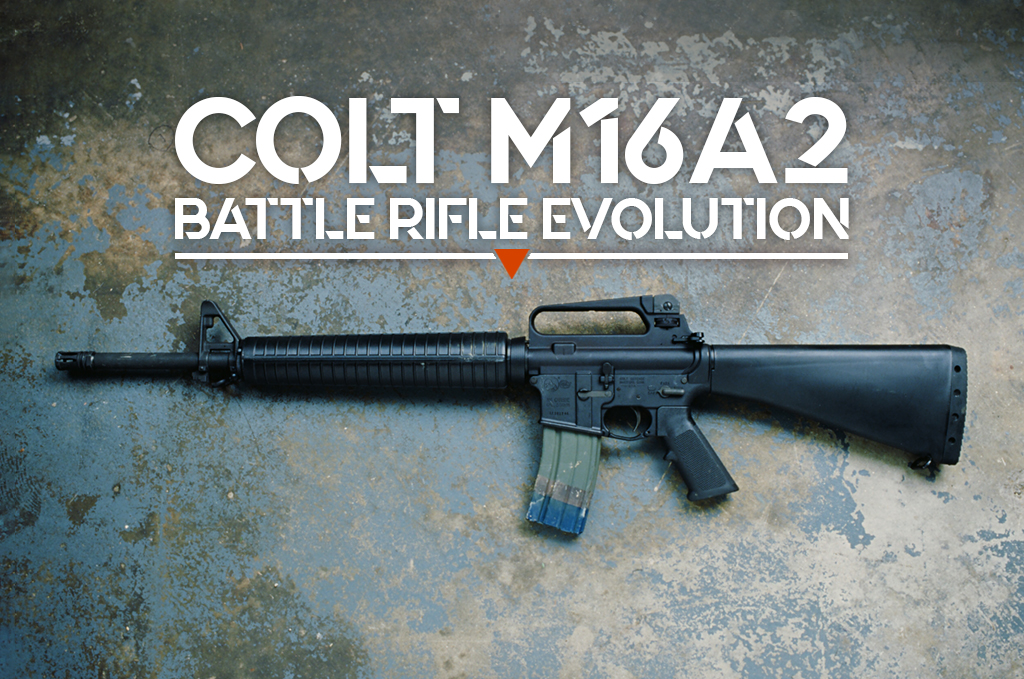
After years of planning and development, the United States Marine Corps adopted the M16A2 in November 1983. An initial order of rifles went to the Marksmanship Training Unit for field testing. This change marked the birth of a firearm that would rise to fame and see military duty in a host of countries, even today. Where did the Colt M16A2 come from? What made this rifle legendary, and why does it refuse to die?
All around the world, if someone says “machine gun,” the likeness of the Colt M16A2 probably springs to mind. While the M16A2 has its faults (we’ll talk about those), it saw combat from the Cold War to the Global War On Terrorism and remained in service in the USMC until the early 2000s. Unsurprisingly, it still sees use worldwide. The history and development of the Colt M16A2 dates to the 1970s, while its DNA remains strong in modern firearms.
The M16A2 evolved from the Vietnam-era M16A1, improving upon its reliability, accuracy, and practicality. This guide explores the beginnings of the Colt M16A2, discusses its rise to power, and outlines some of its pros and cons.
History & Invention: Colt M16A2
The development of the rifle we know as the M16A2 was split between the needs of the U.S. Marine Corps and the U.S Army. Both branches recognized the shortcomings of the M16A1 design and sought out improvements. In short, the military needed a more accurate, more practical rifle, and knew that M16A reliability issues had to be addressed.
Colt worked with the USMC based on its findings using the Product Improvement Program (PIP) to develop a rifle designated as the M16A1E1. After development in the 70s, the M16A1E1 was type-classified as the M16A2 in 1982, and became the official rifle of the USMC in 1983. Colt produced the initial run of 76,000 M16A2 rifles for the USMC.
The primary force behind the design and manufacturing of the M16A2 included Marine, Lt. Col. David Lutz, who served as the program manager overseeing the transition to the M16A2 (read his comments on the project). Several members of Colt, including firearm designer and manufacturer Rob Roy and engineer Harold Waterman, also participated. Of course, with a firearm of this stature, many other hands and minds were behind its creation, including one of the creators of the ArmaLite rifle, Eugene Stoner.
When the U.S. Army got around to adopting the M16A2 in 1986, they had some concerns about the iron sights. They favored the less adjustable, larger aperture used in the M16A1, while the Marines preferred the more adjustable, smaller aperture sights. The Army placed an initial order for 100,176 M16A2 rifles, and Colt fulfilled the order. However, due to labor strikes at manufacturing plants, the U.S. Army dropped Colt in 1988, and Fabrique Nationale (FN) was awarded the contract.
Colt M16A2 Specs
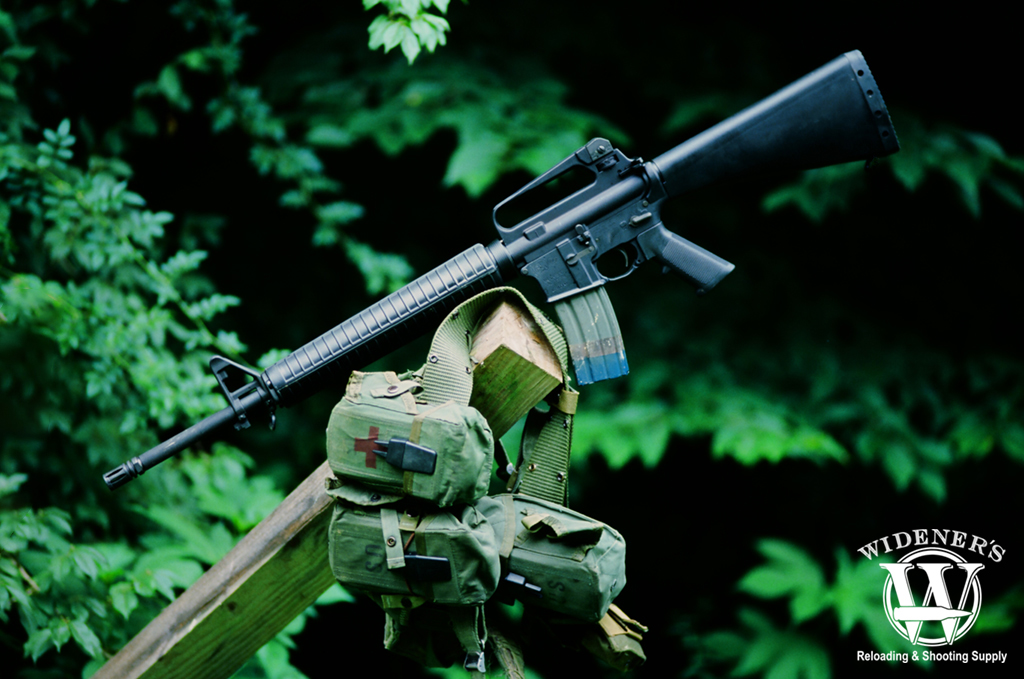
The Colt M16A2 became the service rifle for both the U.S. Marine Corps and the U.S Army.
The M16A2 became the official rifle of multiple military units in the 1980s – and its fame only spread from there. The M16A2 saw use in dozens of countries around the world. Suffice it to say, the M16A2 changed and evolved several times during that span. Operators appreciated some of those changes – and some they did not.
- Caliber: 5.56x45mm NATO.
- Overall Length: 39.63″
- Weight: 7.5 Lbs (Unloaded), 8.79 Lbs (With 30-round magazine).
- M16A2 Barrel Length: 20″ Standard.
- Effective Range: 600 Yards.
- Muzzle Velocity: 3,110 FPS (M855 Ammo).
- Barrel Rifling: 1/7 twist.
- Barrel Profile: Government profile.
- Firing Modes: Semi-automatic and three-round burst.
- Sights: Adjustable rear sight and front sight.
- Capacity: 20 or 30-round detachable magazine.
- Gas System: Direct impingement, gas operated.
Task & Purpose: Colt M16A2
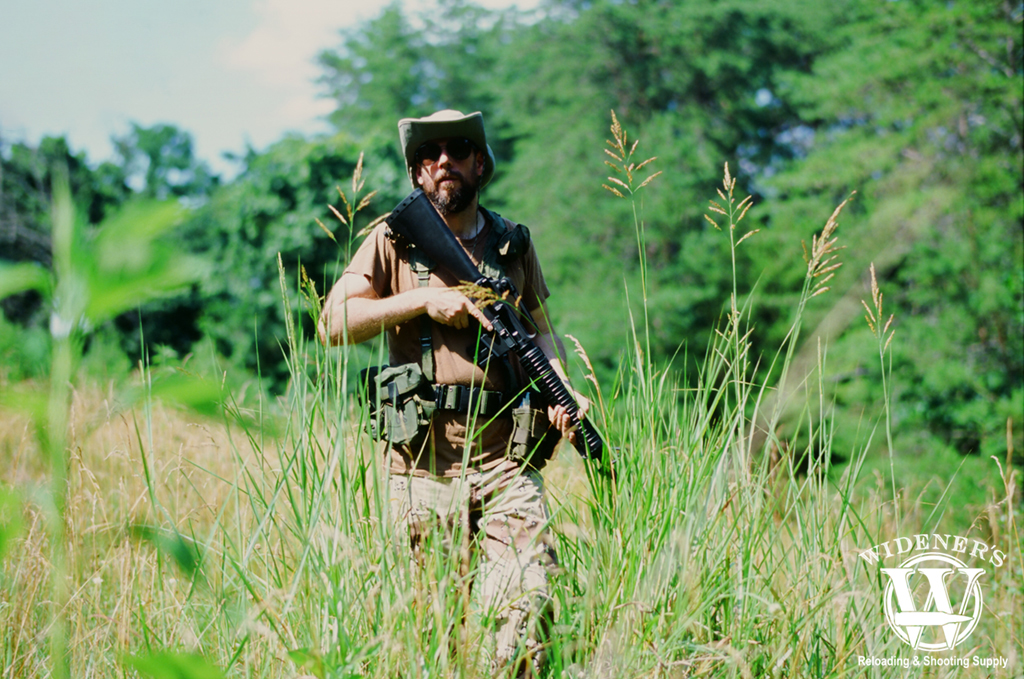
The primary task of the M16A2 rifle was to serve as a more accurate, more practical rifle, with improved reliability.
The M16A2 had a wide application. It became the standard issue to many infantrymen, and it could handle a number of encounters. This rifle saw combat on multiple fronts and worked as the primary companion of many soldiers.
The M16A2 is gas-powered and magazine-fed, proving reliable for multiple applications. The firearm could extend to long ranges (an effective range of around 600 yards and a more practical combat range of about 300). However, the rifle has also seen use in close quarters.
The M16A2 was birthed in the late Cold War era and saw battle through the the Iraq war. While the M16A4 has now largely replaced it (in the United States, at least), there’s still a significant amount of lore and excitement around the history of this rifle.
The M16A2 can handle a 40mm grenade launcher, adding versatility. The rifle had three fire modes: Safe, semi-automatic, and 3-round burst. This burst feature proved controversial, perhaps even problematic.
We’ll talk more about the features of the M16A2, how it differs from its predecessor, and how it lives on.
M16A1 VS M16A2
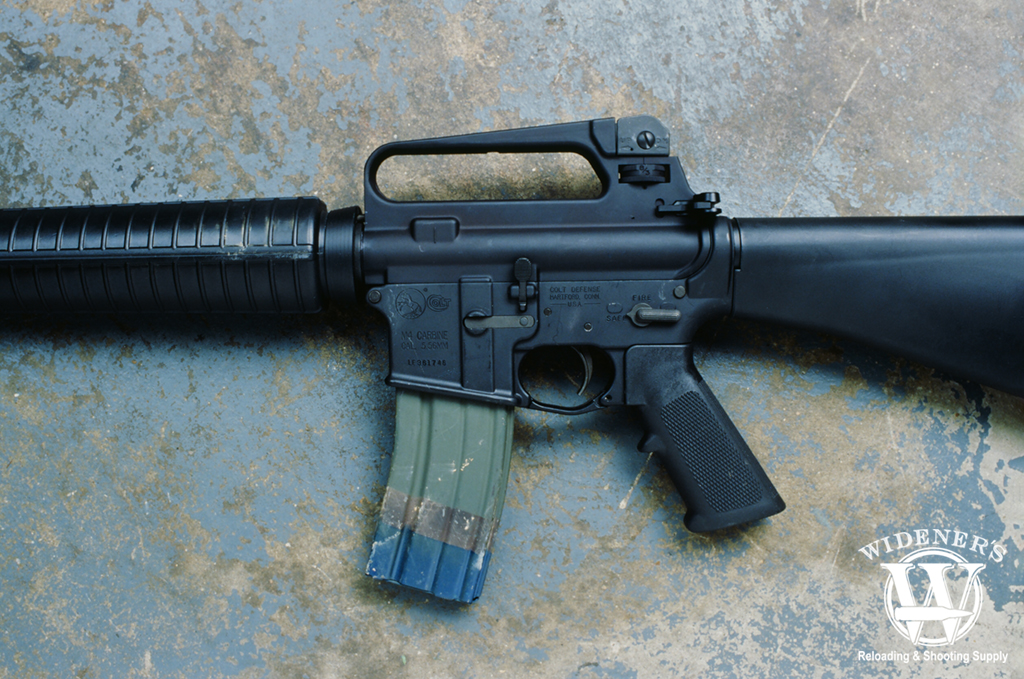
The evolution of the modern battle rifle is evident in the improvements of the Colt M16A2.
The M16A1 was a Vietnam-era weapon, and while it did some things right, there were a few heavy strikes against it. Many firearms experts consider the early M16 rifles a failed experiment in the Vietnam War.
The military pushed out the early M16 in the mid-1960s as an answer to the cumbersome nature of the M14. With soldiers reporting that the Viet Cong armed with AK-47s outmaneuvered them, they wanted to create a lightweight replacement. However, in this scramble for an upgrade, they overlooked a few things in the M16 design, and soldiers ended up with a rifle they weren’t adequately trained to use.
Soldiers reported constant jams, and a famous quote about the M16A1 rifle is that it’s “about as effective as a muzzleloader.” The M16 needed updates, and thus, the program to develop the M16A2 began.
| Rifle Features | M16A1 | M16A2 |
|---|---|---|
| Barrel | Pencil Profile, .625″ Diameter, 1:12 Twist | Government Profile, .750″ Diameter, 1:7 Twist |
| Fire Control | Semi-Auto, Full-Auto | Semi-Auto, 3-Round Burst |
| Rear Sight | Dual Aperture, Windage | Dual Aperture, Windage & Range |
| Brass Case Deflector | None | Behind The Ejection Port |
| Handguards | Triangular, Left/Right Assembly, Round Slip Ring | Round, Top/Bottom Assembly, Tapered Slip Ring |
| Pistol Grip | Moderate Checkering | Aggressive Checkering, Finger Rest Nub |
| Buttstock | Bakelite Resin, Storage Compartment, Moderate Checkering | Zytel Nylon, (.625″ Larger) Storage Compartment, Aggressive Checkering |
| Flash Hider | Holes On Top/Sides/Bottom, Gas Goes Everywhere | Holes On Top/Sides, Gas Goes Up, Out |
Let’s take a closer look at the improvements and other features of the M16A2.
Barrel Differences: M16A1 VS M16A2
The barrel of the M16A1 had two distinct differences from the barrel of the M16A2: the twist rate, and the front-end barrel weight. The M16A1 had a barrel with a twist rate of 1:12, or one twist every 12 inches. It was designed to run 5.56x45mm NATO 55gr M193 ball ammo and M196 tracers.
The updated M16A2 had a barrel twist rate of 1:7. It was designed to run the heavier 5.56x45mm NATO 62gr M855 cartridge. Why the change?
Some reported that the barrel of the M16A1 became hot very quickly when firing rapidly. These hot barrels had a negative effect on accuracy and caused occasional “flyers” with M193 ball ammo and tracers. The faster 1:7 twist rate of the M16A2 barrel addressed this issue and provided more stability. The M16A2’s ability to run the M855 cartridge increased the rifle’s range and penetration and made it a battlefield companion to the M249 SAW.
Barrel Weight Considerations
If you look at the M16A1 barrel and the M16A2 barrel without the handguards, you’ll see a difference in the barrel thickness at the front, ahead of the guards. The thin .625 diameter of the M16A1 barrel is generally characterized as being a “pencil barrel.” In comparison, the front profile of the barrel on the M16A2 is a thicker .750 diameter.
The heavier M16A2 barrel profile prevented flexing, and improved durability, and accuracy for sustained fire. It also allowed for faster rifling to stabilize heavier grain-weight bullets. When it came to accessories, it provided a more stable platform for the M203 grenade launcher.
Some service members were not fans of the additional weight and questioned its accuracy claims. They preferred the simplicity of the M16A1 and the lightweight barrel profile. All while arguing the 5.56x45mm NATO 55gr M193 round was more versatile in combat situations.
Firing Modes: M16A1 VS M16A2
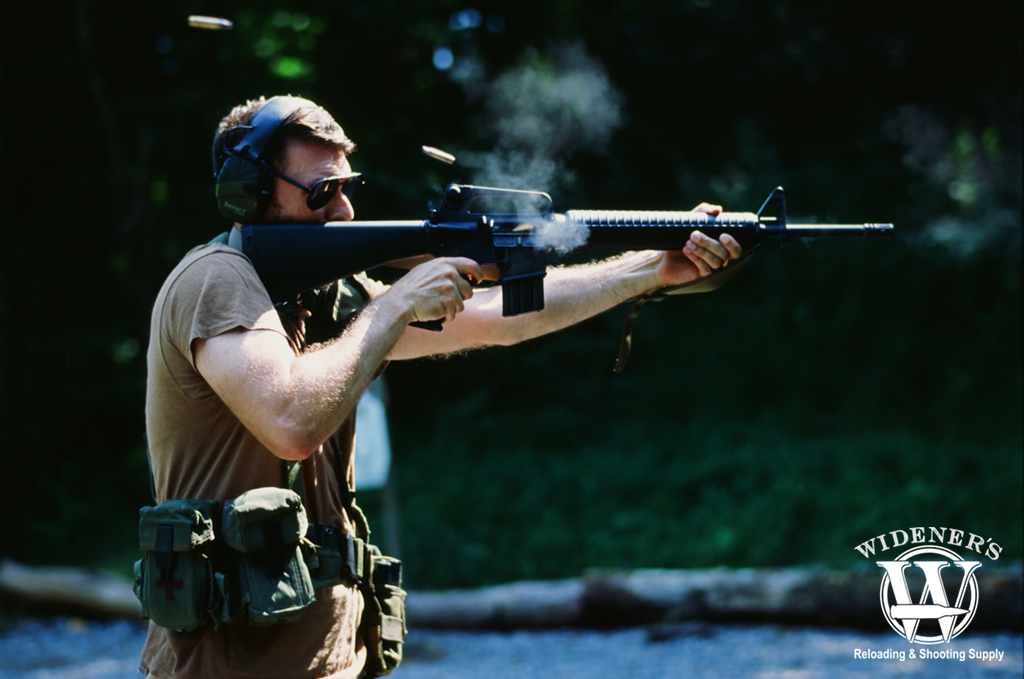
The 3-round burst of the M16A2 was a controversial addition, but remains a feature on the modern M4/M4A1 to this day.
If the new barrel of the M16A2 was a hot topic, the 3-round burst firing mode was molten lava. The M16A1 is fully automatic; however, this caused some concerns about accuracy, lack of control, and wasting ammunition. It’s no secret that the M16A1 also had reliability issues. Running it in full auto (700-900 rounds per minute) often led to fouling issues. These issues led to jams and other unwanted malfunctions.
Burst Mode Advantages
The M16A2 “fixed” these reliability issues by offering a “burst” mode, which allowed soldiers to fire three rounds with one trigger pull. The changes were supposed to help solve the “wasting ammunition problem” – but this change to burst mode is almost universally considered a poor design feature. Why?
- A three-round burst is difficult to keep on target. Designer and patent holder Eugene Stoner is on record saying, “It’s just exactly the wrong number of rounds.” Three rounds of recoil push you as far away from the target as you can go – but the shooter could get the rifle back on target if the gun had a six-round burst.
- The three-round burst had a memory. If you only fire one round, the following trigger pull will only fire two. Some joked that, while on burst mode, you never knew what the rifle would do when you squeezed the trigger. That’s a terrible feature for combat.
- Without fully automatic capability, soldiers struggled to fend off ambushes. You need to lay down heavy fire to defend yourself from an ambush, and with only three-round bursts, that isn’t easy. Some reportedly found ways around this problem, but we won’t get into that here. The three-round burst feature may have made the higher-ups happy to save money on ammunition, but it frustrated many soldiers.
Unique Features: Colt M16A2
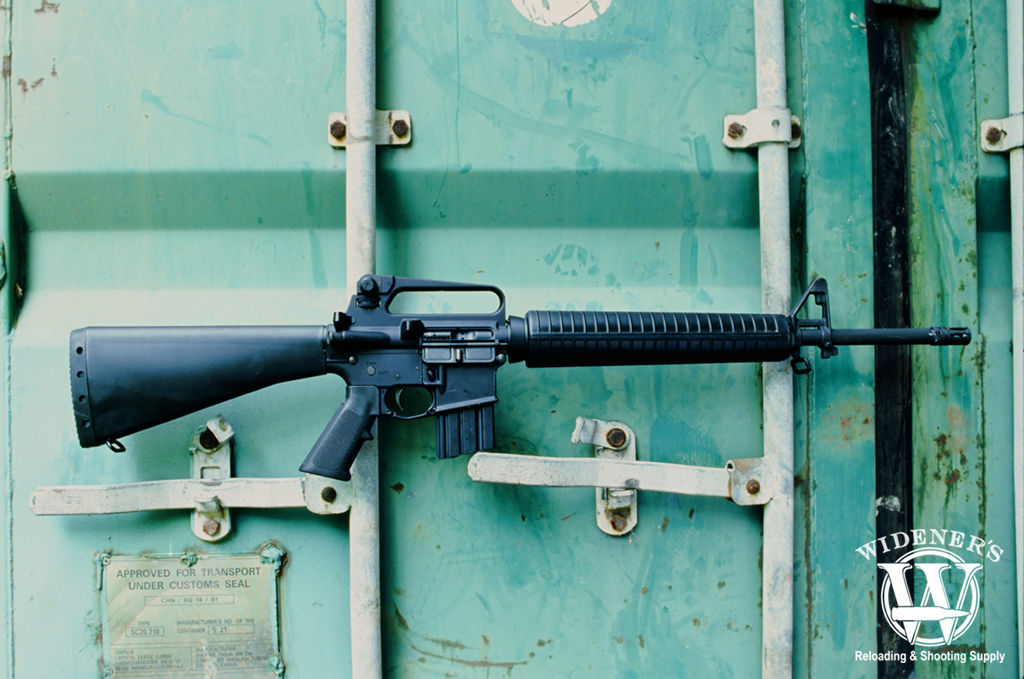
Colt’s legacy of manufacturing includes approximately 8 million M16 rifles produced worldwide.
We touched on some of the controversial changes, but now let’s talk about the other upgrades. The USMC oversaw the development, and you’ll notice a recurring theme of good marksmanship as we delve into the features of the M16A2.
Let’s look at each of these features in a little more depth. Understanding the capabilities of this rifle will also help in understanding its overall story. If you’re curious, here’s a good video detailing the updates of the M16A2
M16A2 Sights
The rear and the front sights on the M16A2 were updated. On the M16A2, the rear sights are adjustable for elevation and windage. This feature made it much easier for soldiers to hone in their rifles when needed. There’s also a flip sight on the back, which allows a change in the aperture.
The front sights also became square, intending to give a clearer picture.
M16A2 Muzzle Break
The flash hider on the M16A2 was another upgrade. On the M16A1, the flash hider was open to all directions, potentially stirring up debris from a prone position (and giving up the soldier’s position).
The M16A2 muzzle break is ported toward the sky. Theoretically, this helps with control and keeps the blast from striking the dirt.
M16A2 Brass Case Deflector
The case deflector protrudes from the right side of the weapon, and it helps control the path of ejected casings. This feature is beneficial when a left-handed shooter handles the weapon, as the casings won’t fly into the operator’s face.
The brass deflector is a positive change that remains on many rifles today.
The Handguards, Grip, & Buttstock
The grips and stock of the M16A2 were also an overall positive change. They were a durability upgrade, molded out of stronger nylon. The concept was to increase stability during usage and reduce slipping in environmental conditions. The benefits were three-fold.
First, the new front handguards were more durable and easier to replace. The handguards of the previous M16A1 were known to crack and break.
Second, the new grip had a more aggressive texture and a nub, or finger groove, added towards the top to improve the user’s purchase.
Third, the material of the buttstock was a more durable glass-filled nylon. But this wasn’t the only positive change to the buttstock. A port at the back of the stock could be opened with just the thumb, making it easy to access cleaning supplies.
M16A4 VS M16A2
In July of 1997, fourteen years after adopting the M16A2, the U.S. Marine Corps announced it was adopting a new rifle, the M16A4. Gone were the carry handle and rear iron sights, and in their place, a flat-top Picatinny rail (MIL-STD-1913) was affixed to the upper receiver. This new rail system allowed for advanced optics and accessories to be mounted directly onto the rifle. The fire control system remained unchanged, with semi-auto, or 3 round burst options. Like its predecessor, the barrel of the M16A4 had a government profile and remained 20″ in length with a 1:7 twist. The M16A4 served as the service rifle for the U.S. Marine Corps from 1997 until 2015.
Colt M16A2 At War
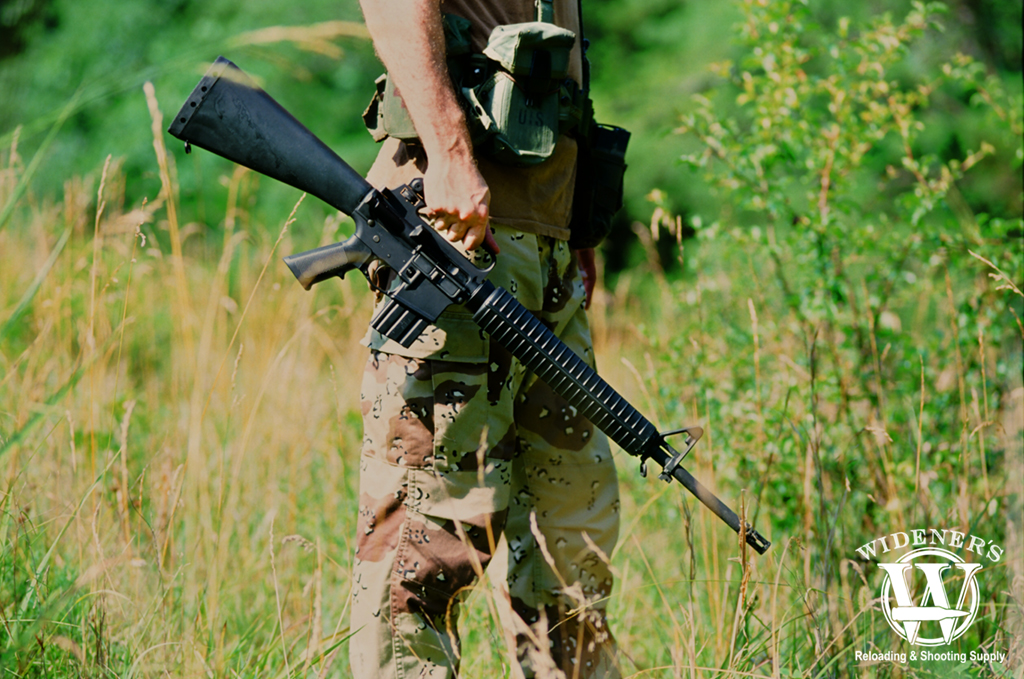
From the Gulf War to engagements in Iraq and Afghanistan, the Colt M16A2 earned its legendary battlefield status.
The Colt M16A2 became the standard issue battle rifle for the U.S. armed forces in the 1980s, serving prominently in conflicts such as the Gulf War and later engagements in Iraq and Afghanistan. In combat, the M16A2 proved to be a reliable and effective service rifle for U.S. forces and allied troops. Its 5.56×45mm NATO round allowed soldiers to carry more ammunition without excessive weight, providing sustained fire in prolonged engagements.
In harsh environments like the deserts of the Gulf War or the mountainous terrain of Afghanistan, the M16A2 generally held up well, though it could be vulnerable to dust. It required regular maintenance to prevent jamming, especially when operating in burst fire mode. Despite these challenges, it remained a key infantry weapon for decades.
Its use on the battlefield has made it one of the most recognizable rifles in modern military history.
Is The Colt M16A2 Still Relevant Today?
The M16A2 was the companion of U.S. forces for nearly three decades. Despite some of the M16A2’s perceived flaws, it proved a reliable weapon in battle. On the civilian gun range, it still holds up well today. Comparing it to other Cold War-era weapons, it doesn’t feel quite as dated, especially with a modern optic attached.
For these reasons, the M16A2 lives on today in many arenas. While this rifle has largely been replaced in the US military forces, it still sees active use worldwide. Its practicality and adaptability make it a viable training option.
Not only that, but the design features and distinct DNA of the M16A2 live on in the M16A4. Given the reputation of the M16A2, it’s appreciated by collectors and those who still find it a practical tool for self-defense. Many still enjoy firing this weapon at the range and learning about this weapon’s unique ties to military history.
Conclusion: Life & Legacy of the Colt M16A2
The M16A2 offered many updates from the M16A1. With a different barrel, upgraded grips, more versatile sights, and a brass case deflector, the M16A2 proved to be a successful companion to many soldiers around the globe.
If you trained on an M16A2, chances are you have some nostalgia for it. Carry handles are cool, fixed stocks rock, and the fun factor is there at the range. It’s an iconic gun that frequently gets screen time in Hollywood films, television shows, and FPS video games.
While the M16A2 wasn’t a perfect firearm, its controversial features paved the way for positive changes in modern weaponry. Many understand the sacrifice made by those who used the original M16 variations and contributed to improving the rifle.
Nikon F3: Guns On Film
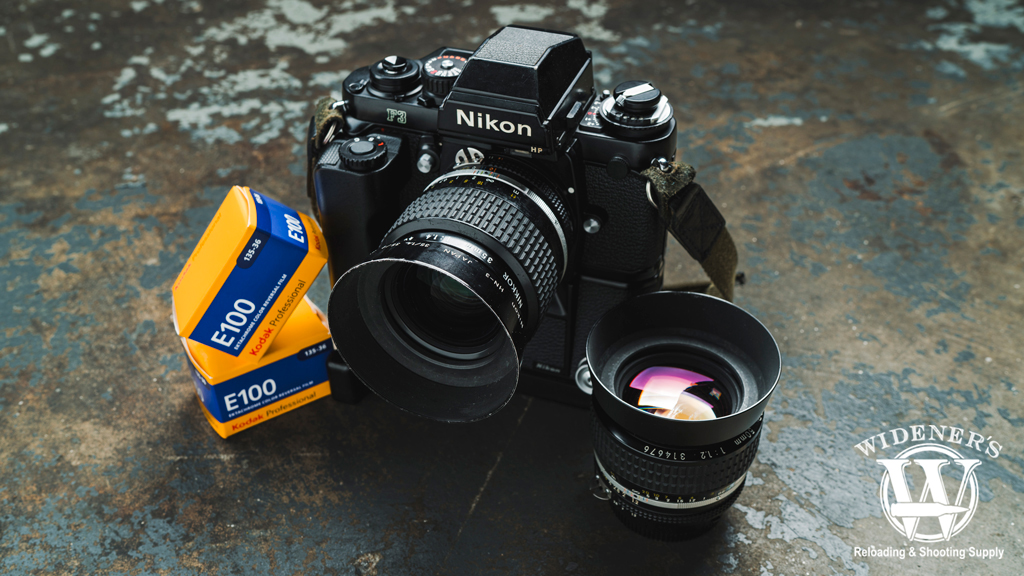
Analog Dreams: Images in this article were captured with a period-correct Nikon F3 HP camera, Nikkor lenses, and Kodak 35mm film.
Editor’s Note: The images featured in this article were captured on 35mm E100 Kodak film, using a Nikon F3 camera, and Nikon Nikkor lenses. The film was processed and scanned by The Great American Photo Lab. Much like the M16A2, the Nikon F3 was introduced in the early 1980’s and became the press camera of a generation. It covered conflicts and combat across seven continents and even went to space in the hands of NASA astronauts.
Countless photojournalists around the globe carried the F3 to the front lines of war zones and international events. Many historical images captured during the invasion of Grenada, the invasion of Panama, Afghanistan, the Iran-Iraq War, and the Persian Gulf War were taken on a Nikon F3. Its rugged build quality, sleek design, and dependability all contribute to its legendary status among camera enthusiasts and professionals.


